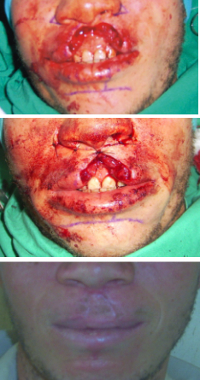Pattern and Management of acquired Facial defects in Imo State University Teaching Hospital, Orlu, Nigeria
Main Article Content
Abstract
Background: The face combines function with important aesthetic implications. With organs and units so closely related a fine balance and symmetry must be maintained in reconstructing facial defects. Imo State University Teaching Hospital Orlu, has the bulk of its patients drawn from neigbouring rural communities and are mainly of a low socioeconomic group. They therefore tend to present late with relatively complicated pathologies. This article looks at the pattern, aetiology and management approach for facial defects in our centre and highlights the challenges faced in managing these patients.
Method: A review of clinical records of consecutive patients with acquired defects of the face managed at the Imo State University Teaching Hospital over a 12 month period was performed. Socio-demographic and clinical data were retrieved and analyzed.
Results: There were 31 patients (15 males and 16 females) with 33 facial defects, and a mean age of 36.2 years. The lips were most commonly involved (30%). The eyelids and eyebrows were least affected. Most defects (48%) followed excision of neoplastic tumors and 87% of these were in Albinos. Human bite was the commonest cause of lip defects. The nasal defects more often required a combination of procedures with multiple theatre sessions.
Ninety one percent (91%) of the defects were reconstructed primarily with good results.
Conclusion: Surgical excision of squamous cell cancers in albinos and human bite are the commonest causes of facial defects in our environment. In reconstructing facial defects of diverse aetiologies, adherence to laid down principles of facial reconstruction is necessary to achieve consistently acceptable results. We recommend primary repair of acquired facial defects as this gives optimal results. Correspondence:
Downloads
Article Details
Section

This work is licensed under a Creative Commons Attribution-NonCommercial-NoDerivatives 4.0 International License.
The Journal is owned, published and copyrighted by the Nigerian Medical Association, River state Branch. The copyright of papers published are vested in the journal and the publisher. In line with our open access policy and the Creative Commons Attribution License policy authors are allowed to share their work with an acknowledgement of the work's authorship and initial publication in this journal.
This is an open access journal which means that all content is freely available without charge to the user or his/her institution. Users are allowed to read, download, copy, distribute, print, search, or link to the full texts of the articles in this journal without asking prior permission from the publisher or the author.
The use of general descriptive names, trade names, trademarks, and so forth in this publication, even if not specifically identified, does not imply that these names are not protected by the relevant laws and regulations. While the advice and information in this journal are believed to be true and accurate on the date of its going to press, neither the authors, the editors, nor the publisher can accept any legal responsibility for any errors or omissions that may be made. The publisher makes no warranty, express or implied, with respect to the material contained herein.
TNHJ also supports open access archiving of articles published in the journal after three months of publication. Authors are permitted and encouraged to post their work online (e.g, in institutional repositories or on their website) within the stated period, as it can lead to productive exchanges, as well as earlier and greater citation of published work (See The Effect of Open Access). All requests for permission for open access archiving outside this period should be sent to the editor via email to editor@tnhjph.com.
How to Cite
References
Gonzalez-Ulloa M. Restoration of the face covering by means of selected skin in regional aesthetic units. Br. J. Plast. Surg. 1956; 9: 212.
Fattahi. T. An overview of facial aesthetic units. Journal of Oral and maxillofacial Surgery. 2003; 61: 1207-1211.
Millard DR. Jr. Aesthetic reconstructive rhinoplasty. Clin. Plast. Surg. 1981; 8: 169.
Zide BM: Deformities of the lips and cheeks. In McCarthy JG(ed), Plastic Surgery. Philadelphia, WB Saunders, 1990; 3: 2009 2056.
Clevens RA, Baker SR. Conceptual considerations in head and neck reconstruction. Otolaryngol. Clin. North Am. Aug. 1997; 30(4): 495 517.
Higgenson J, Otettle AG. Cancer in South African Bantu. J. Natl Cancer Inst. 1960; 24: 643 647.
Iversen U, Iversen OH. Tumors of the skin. In Templeton AC(ed): Tumours in a tropical country. A survey of Uganda 1964-1968. New York, Springer-Verlag, 1973;180-199.
Yakubu A, Mabogunje O A. - Skin cancer in African albinos. Acta Oncol 1993; 2: 621-622.
Kromberg J G, Castle D, Zwane E M, Jenkins T. - Albinism and skin cancer in Southern Africa. Clin Genet 1989; 36: 43-52.
George AA, Ulrich KH. Advanced skin cancers in Tanzanian Albinos. Preliminary observations. J Natl. Med. Assoc. 1981; 73: 1047-1054.
Okoro AN. Albinism in Nigeria: A clinical and social study. Br. J Dermatol. 1975; 92: 485-492.
Gill PS, Bidros RS, Boutros S. Reconstruction ofOncologic defects of the eyelids, lips and ear. Indian Journal of Plastic Surgery. 2007; 40 (12):13 - 21.
Jackson IT. Use of tongue flaps to resurface lip defects and close palatal Fistulae in children. Plast Reconstr Surg 1972; 49:537.
William PA Jr, Samuel JB. Lip, Cheek, and Scalp reconstruction; Hair Replacement. Selected readings in Plastic Surgery. 2001; 9(15):18.
Barry MZ, Rafael CC. In; Sherrell JA, Robert WB, thCharles HT, eds. Grabb and Smith's Plastic Surgery. 5ed. Lippincott-Raven, 1997: 501-512.
Datubo-Brown DD. Human bites of the face with tissue loss. Annals of Plast Surg. 1988; 21: 322-328.
Uchendu BO. Primary closure of human bite losses ofthe lip. Plast and reconstr surg. 1992; 90(5):841-845.
Akpuaka FC, Jiburum BC. The use of keloidal skin The Nigerian Health Journal, Vol. 11, No 1, January - March 201
Opara K.O, Jiburum B.C Acquired facial defects in Nigeriaflaps in the treatment of moderate sized keloids. Orient journal of medicine. 1994; 6:54-56.

